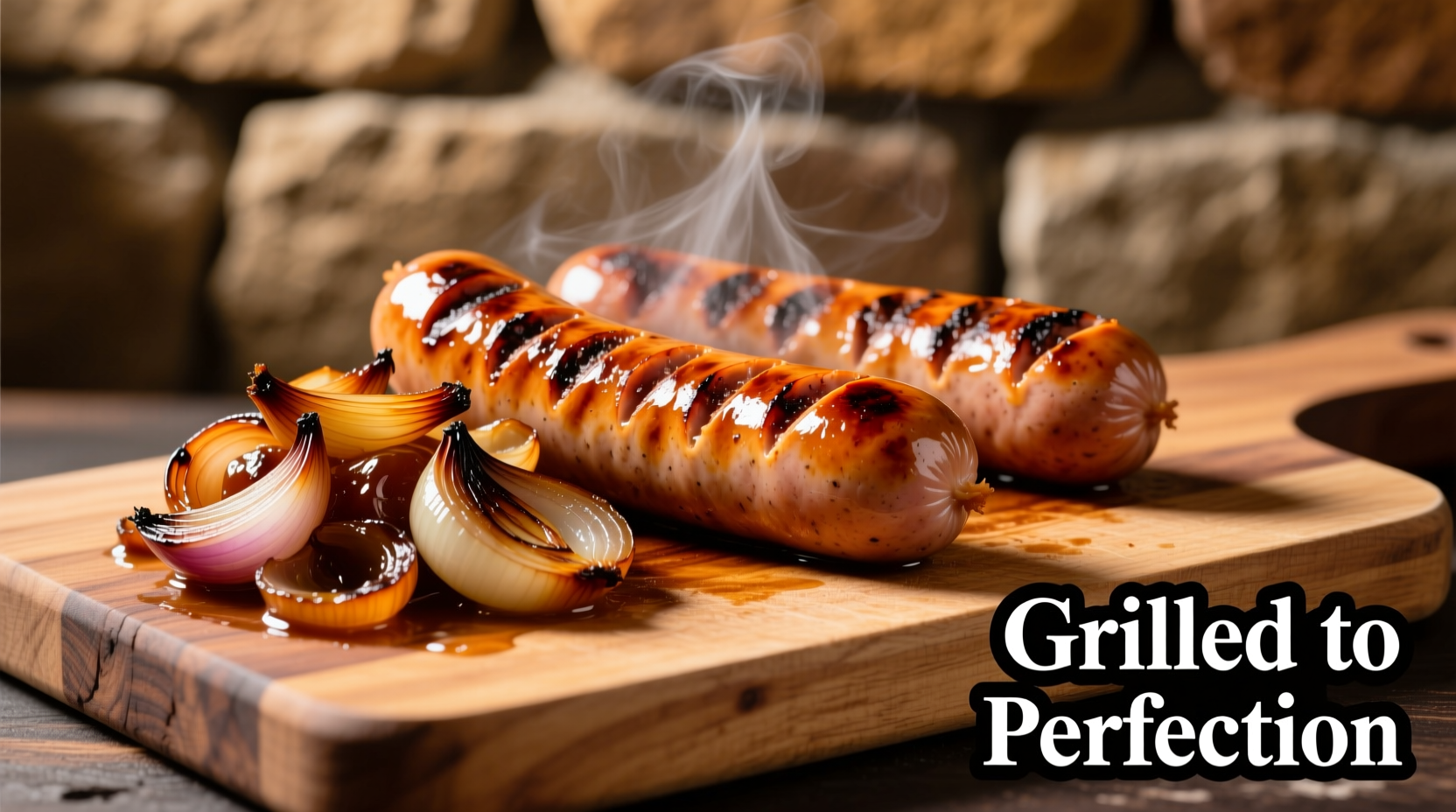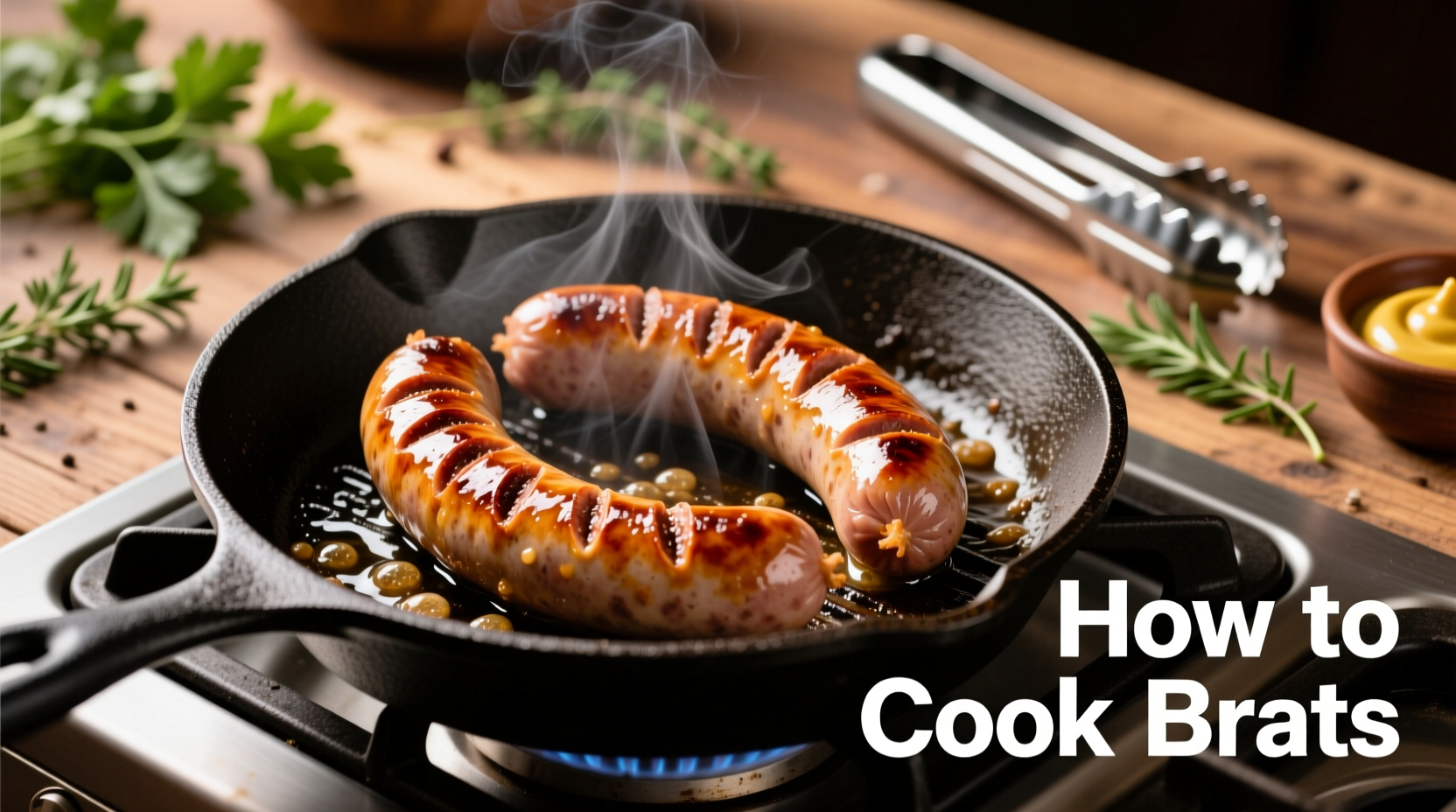Perfectly cooked brats reach an internal temperature of 160°F (71°C), taking 15-20 minutes on a preheated grill at medium heat. Never pierce the casing—this releases flavorful juices. For best results, cook slowly over indirect heat after initial searing, and consider simmering in beer first for enhanced tenderness and flavor absorption.
The Ultimate Guide to Cooking Bratwurst: Methods, Timing, and Pro Tips
Bratwurst, the beloved German sausage, has become a staple at American cookouts and kitchen tables. Whether you're hosting a backyard barbecue or preparing a quick weeknight dinner, knowing how to cook brats properly ensures juicy, flavorful results every time. This comprehensive guide covers all essential methods, timing considerations, and professional techniques that transform ordinary brats into extraordinary meals.
Understanding Bratwurst: More Than Just Sausage
Bratwurst ("brat" for short) originates from Germany, with regional variations across Bavaria, Thuringia, and beyond. Traditional brats contain pork, though modern versions may include veal or beef. The key to their distinctive flavor lies in the seasoning blend—typically featuring nutmeg, ginger, caraway, and white pepper. Unlike some sausages, authentic brats contain no fillers, making proper cooking technique essential to prevent dryness.
| Cooking Method | Time Required | Best For | Temperature Guide |
|---|---|---|---|
| Grill (Direct/Indirect) | 15-20 minutes | Outdoor gatherings, authentic flavor | Medium heat (350-375°F) |
| Stovetop (Skillet) | 12-15 minutes | Weeknight meals, limited equipment | Medium heat with occasional turning |
| Beer-Steamed | 20-25 minutes | Traditional preparation, maximum tenderness | Gentle simmer (180-200°F) |
| Oven | 20-25 minutes | Large batches, consistent results | 375°F convection setting |
Essential Preparation Steps Before Cooking Brats
Proper preparation sets the foundation for perfectly cooked brats. Remove brats from refrigeration 20 minutes before cooking to bring them closer to room temperature—this promotes even cooking. Never pierce the casings during preparation, as this releases the precious fat and juices that keep brats moist. If using frozen brats, thaw completely in the refrigerator overnight rather than using quick-thaw methods that compromise texture.
For traditional preparation, many chefs recommend the "beer bath" method before grilling. Simmer brats gently in a mixture of beer, onions, and spices for 10-15 minutes. This partial cooking ensures thorough heating while infusing additional flavor. The USDA Food Safety and Inspection Service confirms that pre-cooking sausages in liquid reduces the risk of undercooking while maintaining food safety standards (fsis.usda.gov/sausage-safety).

Mastering the Grill Method: Step-by-Step
Grilling remains the most popular method for how to cook brats on the grill with authentic flavor. Follow these professional steps:
- Preheat your grill to medium heat (350-375°F) with both direct and indirect zones
- Sear brats over direct heat for 2-3 minutes per side until golden brown
- Move to indirect heat and continue cooking for 12-15 minutes
- Turn occasionally until internal temperature reaches 160°F
- Rest for 3-5 minutes before serving
The two-zone grilling technique prevents casing rupture while ensuring thorough cooking. According to culinary research from the Culinary Institute of America, the resting period allows juices to redistribute throughout the sausage, resulting in noticeably juicier brats (ciachef.edu/sausage-cooking).
Alternative Cooking Methods for Any Situation
Stovetop Skillet Method
When outdoor grilling isn't possible, the stovetop method delivers excellent results. Heat a cast-iron skillet over medium heat with one tablespoon of oil. Add brats and cook for 3-4 minutes per side until browned. Reduce heat to medium-low, add ½ cup of liquid (beer, broth, or water), cover, and simmer for 10-12 minutes until reaching 160°F internally. This approach works particularly well for how to cook brats inside without a grill.
Beer-Steamed Brats (Traditional Wisconsin Style)
This method, popular in Wisconsin where German immigrants settled, involves simmering brats in beer before finishing on the grill. Combine one bottle of lager-style beer, sliced onions, and brats in a large pot. Simmer gently for 15 minutes (do not boil vigorously), then finish on the grill for 5 minutes to develop caramelization. The Wisconsin Historical Society documents this technique as part of the state's culinary heritage since the 1850s (wisconsinhistory.org/bratwurst-history).
Determining Perfect Doneness: Beyond Guesswork
Visual cues alone can't reliably indicate when brats are properly cooked. The only accurate method is using an instant-read thermometer. Insert the thermometer into the thickest part of the brat, avoiding the casing. Properly cooked brats register 160°F (71°C). At this temperature, the meat will be firm but still juicy, with no pink remaining.
Many home cooks make the mistake of cutting into brats to check doneness—this releases precious juices and dries out the sausage. Trust your thermometer instead. The USDA recommends this precise temperature measurement for all ground meats to ensure food safety while preserving quality.
Avoiding Common Bratwurst Cooking Mistakes
Even experienced cooks make these critical errors when preparing brats:
- Piercing the casing—releases flavorful juices and causes dryness
- High-heat cooking—creates uneven cooking and casing rupture
- Skipping the resting period—prevents juice redistribution
- Overcrowding the cooking surface—lowers temperature and steams instead of sears
- Using only visual cues—leads to under or overcooking
Professional chefs emphasize that patience yields the best results. Cooking brats slowly over medium heat allows the fat to render properly and the casing to develop that desirable snap without splitting.
Serving Suggestions and Traditional Accompaniments
Serve cooked brats on split-top buns with classic toppings: caramelized onions, sauerkraut, and mustard. For authentic German presentation, pair with potato salad or red cabbage. Modern variations include:
- Bratwurst pizza with caramelized onions and sauerkraut
- Brat sliders with beer-braised onions
- Breakfast brats with scrambled eggs and peppers
- Bratwurst pasta with cream sauce and peas
Consider the context when choosing your serving style. Outdoor gatherings typically call for traditional presentation, while weeknight meals might benefit from creative adaptations that incorporate brats into familiar dishes.
Storage and Reheating Guidelines
Store cooked brats in an airtight container in the refrigerator for up to four days. For longer storage, freeze cooked brats for up to three months. When reheating, avoid the microwave which can make casings tough. Instead, warm brats gently in a covered skillet with a small amount of liquid (beer or broth) over low heat for 5-7 minutes. This method preserves texture and flavor better than other reheating techniques.
Frequently Asked Questions
Do you have to boil brats before grilling?
Boiling brats before grilling is not required but recommended for traditional preparation. Simmering in beer or broth for 10-15 minutes ensures thorough cooking while adding flavor. However, you can grill raw brats directly using the two-zone method—just cook longer over indirect heat to reach 160°F internally without burning the exterior.
How long does it take to cook brats on the grill?
Brats typically take 15-20 minutes to cook on a medium-heat grill (350-375°F). Start with 2-3 minutes per side over direct heat for searing, then move to indirect heat for 12-15 minutes, turning occasionally until they reach 160°F internally. Larger brats may require additional time.
Can you cook brats in the oven?
Yes, you can cook brats in the oven at 375°F for 20-25 minutes. Place them on a parchment-lined baking sheet, turning halfway through cooking. For better results, finish under the broiler for 2-3 minutes to develop browning. Oven cooking works well for preparing multiple brats consistently without constant attention.
What's the best beer to use for cooking brats?
Lager-style beers work best for cooking brats as they complement rather than overpower the sausage flavor. German-style pilsners, helles lagers, or American lagers provide the ideal balance of malt and hops. Avoid strongly flavored beers like IPAs or stouts, which can make the brats taste bitter. Non-alcoholic beer works well too if you prefer to avoid alcohol.
How do you know when brats are done without a thermometer?
While a thermometer is the only reliable method, visual and tactile cues can indicate doneness: the casing should be browned and slightly crisp, the brat should feel firm but not hard when gently squeezed, and juices should run clear (not pink). However, these methods are less accurate than using a thermometer to verify 160°F internal temperature for food safety.











 浙公网安备
33010002000092号
浙公网安备
33010002000092号 浙B2-20120091-4
浙B2-20120091-4